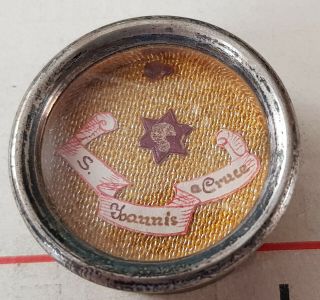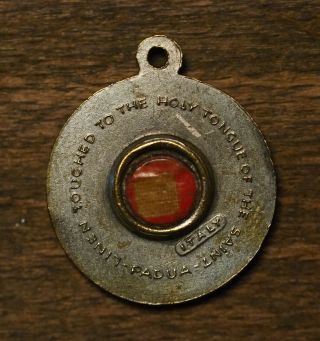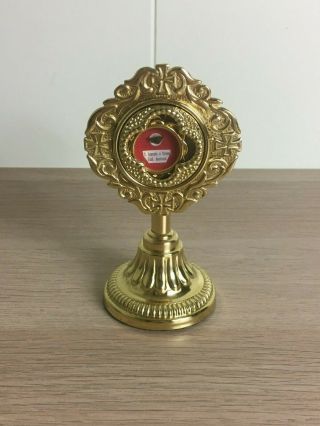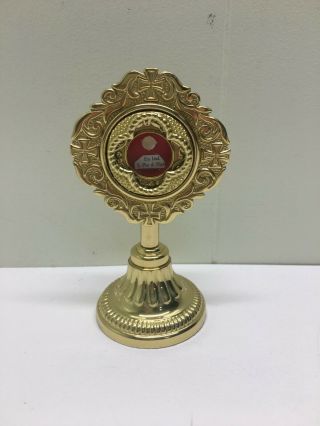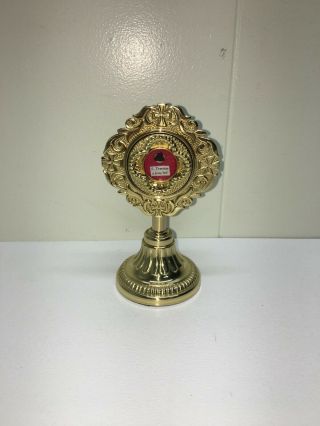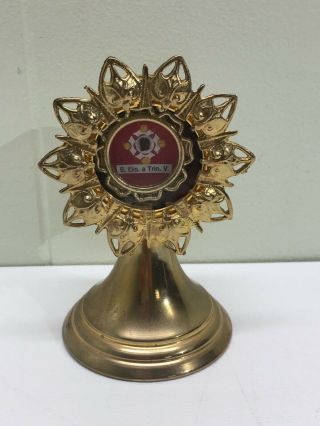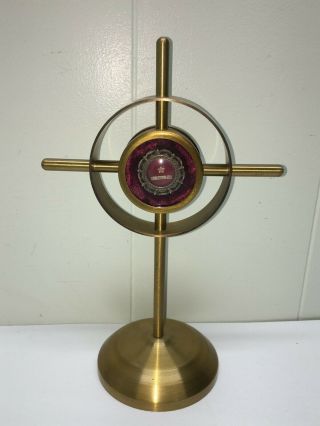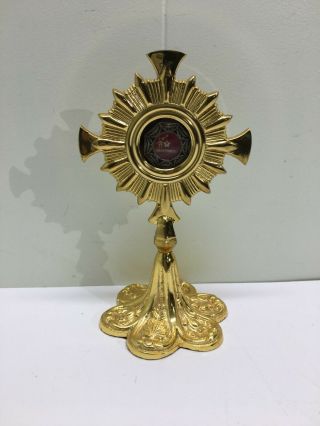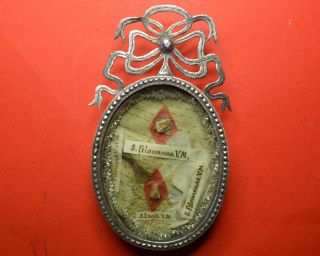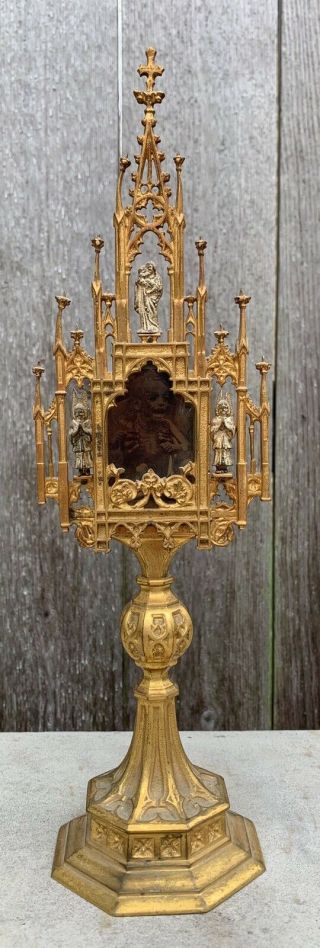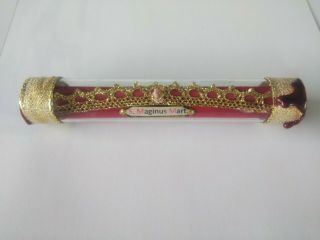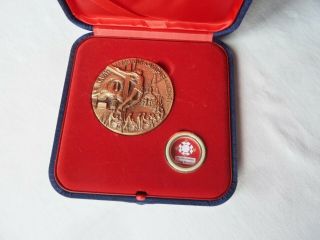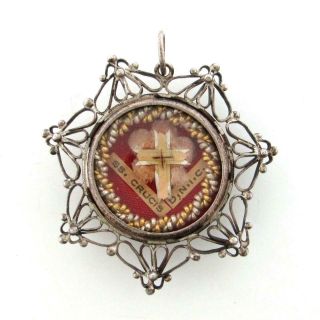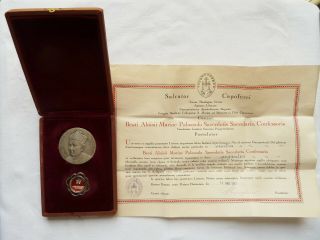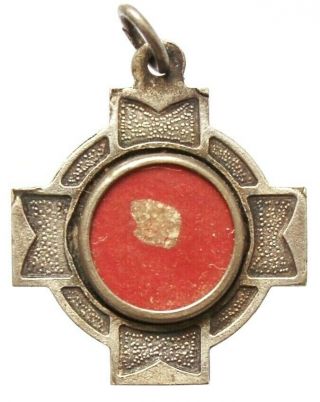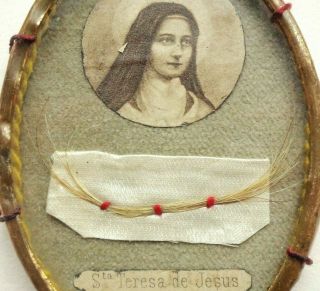Reliquary 12 X Important Relic Saint Nicholas Of Myra, Augustine, Thomas The Ap
Item History & Price
| Reference Number: Avaluer:4312153 |
This is a antique brass pendant, inside12important first class relics of Saint Charles Borromeo, Saint Thomas the Apostle, Saint Ambrose of Milan, Saint Jerome, Saint Roch, Saint Nicholas of Tolentino, Saint Nicholas of Myra, SaintJoseph of Cupertino, Saint Blaise, Saint Augustine of Hippo, Saint Benedict ofNursia and Saint Cajetan.Relics in place and waxseal and threads intact.Coming from a convent in Italy.Measures 3, 9x2, 9 inch.Shipping and handling US$ ...22.00 by insured priority mail and tracking number.
All my items are securely packet, to avoid all possibledamage ( look at my feedback). I prefure payment by Paypal. With multipleitems, I will combine shipping. All my items are securely packet, to avoid allpossible damage. I prefure payment by Paypal . Please contact me if you have any questions. Items cannot be returned!
Please see my other auctions for more antique catholicitems.
Ifyour feedback is less than 5, please contact us with name, adres &phonenumber prior to bidding.
Please be carefull when buying relics online. Fake relics areincreasingly more and more of a problem. Most of the relics I sell are fromconvents in Belgium and Italy. I have been collecting relics for more than 25years. I consider myself an expert. Please contact me if youhave any questions.
Our Non Paying Buyer process is now automaticallymanaged by Ebay.
The process starts four days after auction end and closes as soon as payment isreceived or automatically after the eighth day.
Saint Thomas theApostle
Alsoknown as
Apostle of India Didymus Doubting Thomas Judas Thomas the Twin Tomaso
Memorial
3 July 21 December on some calendars
Profile
Apostle. He was ready to die with Jesus when Christwent to Jerusalem, but is best remembered for doubting the Resurrection untilallowed to touch Christ’s wounds. Preached in Parthia, Persia and India, thoughhe was so reluctant to start the mission that he had to be taken into slaveryby a merchant headed that way. He eventually gave in to God‘s will, was freed, and planted the new Church over a wide area. He formed many parishes and builtmany churches along the way. An old tradition says that Thomas baptised thewise men from the Nativity into Christianity.
His symbol is the builder’s square; there are severalstories that explain it
hebuilt a palace for King Guduphara in Indiahebuilt the first church in India with his own handsitis representative building a strong spiritual foundation as he had completefaith in Christ (though initially less in the Resurrection)heoffered to build a palace for an Indian king that would last forever; the kinggave him money, which Thomas promptly gave away to the poor; he explained thatthe palace he was building was in heaven, not on earthDied
stabbed with a spear c.72 in while in prayer on a hill in Mylapur, India buried near the site of his death relics later moved to Edessa, Mesopotamia relics moved to Tortona, Italy in the 13th century
Canonized
Pre-Congregation
Patronage
against blindness against doubt architects blind people builders construction workers geometricians masons people in doubt stone masons stonecutters surveyors theologians Ceylon East Indies India Indonesia Malaysia Pakistan Singapore Sri Lanka Bathery, India, diocese of Castelfranco di Sopra, Italy Certaldo, Italy Ortona, Italy
Saint Ambrose ofMilan
Alsoknown as
Ambreuil Ambrogio Ambroise Ambrosius AmbrunEmbrun The Honey Tongued Doctor
Memorial
7 December (anniversary of his ordination) 4 April (Old Catholics; Lutherans; Milan, Italy for the memorial of his death) 20 December (Orthodox)
Profile
Born to the Roman nobility. Brother of Saint Marcellinaand Saint Satyrus. Educated in the classics, Greek, and philosophy at Rome, Italy.Poet and noted orator. Convert to Christianity. Governor of Milan, Italy.
When the bishop of Milan died, a dispute over hisreplacement led to violence. Ambrose intervened to calm both sides; heimpressed everyone involved so much that though he was still an unbaptized catechumen, he was chosen as the new bishop. He resisted, claiming that he was not worthy, but to prevent further violence, he assented, and on 7 December 374 he was baptized, ordained as a priest, and consecrated as bishop. He immediately gave away hiswealth to the Church and the poor, both for the good it did, and as an exampleto his flock.
Noted preacher and teacher, a Bible student of renown, and writer of liturgical hymns. He stood firm against paganism and Arians. His preachinghelped convert Saint Augustine of Hippo, whom Ambrose baptized and brought intothe Church. Ambrose’s preaching brought Emperor Theodosius to do public penancefor his sins. He called and chaired several theological councils during histime as bishop, many devoted to fighting heresy. Welcomed Saint Ursus and SaintAlban of Mainz when they fled Naxos to escape Arian persecution, and then sentthem on to evangelize in Gaul and Germany. Proclaimed a great Doctor of theLatin Church by Pope Boniface VIII in 1298.
The title HoneyTongued Doctor was initially bestowed on Ambrose because of his speakingand preaching ability; this led to the use of a beehive and bees in his iconography, symbols which also indicate wisdom. This led to his association with bees, beekeepers, chandlers, wax refiners, etc.
Born
c.340 in Trier, southern Gaul (modern Germany)
Died
Holy Saturday, 4 April 397 at Milan, Italy of natural causes relics at basilica of Milan
Canonized
Pre-Congregation
Patronage
bee keepers bees bishops candle makers chandlers domestic animals French Commissariat geese honey cake bakers learning livestock police officers schoolchildren security personnel starlings students wax melters wax refiners Milan, Italy, archdiocese of Alassio, Italy Bologna, Italy Lombardy, Italy Lonate Pozzolo, Italy Milan, Italy Monte San Savino, Italy Stresa, Italy Vigevano, Italy
Saint Jerome
Alsoknown as
Eusebius Hieronymus Sophronius Girolamo Hieronymus Jerom Man of the Bible
Memorial
30 September 15 June (Eastern calendar) 9 May (translation of relics)
Profile
Born to a rich pagan family, Jerome led a wild andmisspent youth. Studied in Rome, Italy, and became a lawyer. He converted andjoined the Church in theory, and was baptised in 365, but it was only when hebegan his study of theology that he had a true conversion and the faith becameintegral to his life.
He became a monk, then, needing isolation for hisstudy of Scripture, he lived for years as a hermit in the Syrian deserts. Therehe is reported to have drawn a thorn from a lion‘s paw; the animal stayedloyally at his side for years.
Priest. Student of Saint Gregory of Nazianzen. Secretaryto Pope Damasus I who commissioned Jerome to revise the Latin text of theBible. The result was 30 years of work which we know as the Vulgate translation, the standardLatin version for over a millenia, and which is still in use today.
Friend and teacher of Saint Paula, Saint Marcella, andSaint Eustochium, an association that led to so much gossip that Jerome left Rometo return to desert solitude. He lived his last 34 years in the Holy Land as asemi-recluse, writing and translating works of history, biography, the writingsof Origen, and much more. Doctor of the Church and Father of the Church. Sincehis own time, he has been associated in the popular mind with scrolls, writing, cataloging, translating, which led to those who work in such fields taking himas their patron – a man who knew their lives and problems.
Born
347 at Strido, Dalmatia
Died
419 of natural causes interred in Bethlehem relics at the Basilica of Saint Mary Major in Rome, Italy
Canonized
Pre-Congregation
Patronage
archeologists archivists Bible scholars librarians libraries schoolchildren students translators Saint-Jérôme, Quebec, city of Saint-Jérôme, Québec, diocese of Taos Indian Pueblo
Saint Roch
Alsoknown as
Roc Rocco Roche Rochus Rock Rocke Rollock Rollox Roque Seemirookie
Memorial
16 August
Profile
French noble who early developed a sympathy for the poorand sick; reported to have been born with the image of a red cross on hisbreast. Orphaned at age 20, he gave his fortune to the poor, and became amendicant pilgrim; may have been a Franciscan tertiary. While on pilgrimageRoch encountered an area afflicted with plague. He stayed to minister to the sick, and affected several miraculous cures, usually by making the sign of the crossover them, but contracted the plague himself. He walked into a forest to die, but was befriended by a dog. The dog fed him with food stolen from his master’stable, and Roch eventually recovered.
When Roch returned to Montpellier, France, he was arrestedfor being a spy. He languished in jail for five years, never mentioning hisnoble connections, cared for by an angel until his death.
Born
1295 at Montpelier, France
Died
1327 at Montpelier or Angleria, France of natural causes relics in Venice, Italy in the church of San Rocco; in Rome, Italy; and in Arles, France
Patronage
against cholera against diseased cattle against epidemics against knee problems against plague against skin diseases against skin rashes bachelors diseased cattle dogs falsely accused people invalids relief from pestilencesurgeons tile makers Tagbilaran, Philippines, diocese of Drniš, Croatia Albaredo d’Adige, Italy Balzola, Italy Barano, Italy Bisegna, Italy Butera, Italy Carbonara Scrivia, Italy Casalnoceto, Italy Castelnuovo Don Bosco, Italy Castropignano, Italy Cereseto, Alessandria, Italy Cernusco Lombardone, Italy Dusino San Michele, Italy Labico, Italy Lillianes, Italy Locorotondo, Italy (since 1787) Lucera, Italy Orsogna, Italy Patricia, Italy Potenza, Italy Pozzi, Italy Ripacandida, Italy Rocca Priora, Italy Trebisacce, Italy
Saint Nicholas ofTolentino
Alsoknown as
Niccolò da Tolentino Nicola da Tolentino Nicolás de Tolentino Patron of Holy Souls
Memorial
10 September
Profile
His middle-aged parents, Compagnonus de Guarutti andAmata de Guidiani, were childless until a prayerful visit to a shrine of Saint Nicholasof Myra at Bari, Italy. In gratitude, the couple named their son Nicholas.
Nicholas became an Augustinian friar at age 18, and a studentwith Blessed Angelus de Scarpetti. Monk at Recanati and Macerata in Italy. Ordainedat age 25. Canon of Saint Saviour’s. There he received visions of angelsreciting the phrase “to Tolentino“;he took this as a sign to move to that city in 1274, and there he lived therest of his life.
Worked as a peacemaker in a city torn by civil war. Preachedevery day, wonder-worker and healer, and visited prisoners. He always toldthose he helped, “Say nothing ofthis.” Received visions, including images of Purgatory, which friendsascribed to his lengthy fasts. Nicholas had a great devotion to the recently dead, praying for the souls in Purgatory as he travelled around his parish, and oftenlate into the night.
Once, when severely ill, he had a vision of the BlessedVirgin Mary, Augustine of Hippo and Monica. They told him to eat a certain typeof roll that had been dipped in water. Cured, he began healing others byadministering bread over which he recited Marian prayers. The rolls becameknown as Saint Nicholas Bread, and are still distributed at his shrine.
Reported to have resurrected over one hundred dead children, including several who had drowned together. Legend says that the devil oncebeat Nicholas with a stick; the stick was displayed for years in the hischurch. A vegetarian, Nicholas was once served a roasted fowl; he made the signof the cross over the bird, and it flew out a window. Nine passengers on shipgoing down at sea once asked for the aid of Saint Nicholas; he appeared in thesky, wearing the black Augustinian habit, radiating golden light, holding a lilyin his left hand; with his right hand he quelled the storm. An apparition ofthe saint once saved the burning palace of the Doge of Venice by throwing apiece of blessed bread on the flames.
Born
1245 at Sant’Angelo, March of Ancona, diocese of Fermo, Italy
Died
10 September 1305 at Tolentino, Italy following a long illness relics re-discovered at Tolentino in 1926 in previous times his relics were known exude blood when the Church was in danger
Canonized
5 June (Pentecost) 1446 by Pope Eugene IV over 300 miracles were recognized by the Congregation
Patronage
animals babies (reported to have raised more than 100 children from the dead) boatmen dying people mariners sailors sick animals souls in Purgatory watermen Albi, Italy Cabanatuan, Iloilo, Philippines. diocese of Guimbal, Iloilo, Philippines Lambunao, Iloilo, Philippines Mati, Philippines, diocese of Surigao City, Philippines Tandag, Philippines, diocese of Tolentino, Italy
Saint Nicholas ofMyra
Alsoknown as
Nicholas of Bari Nicholas of Lpnenskij Nicholas of Lipno Nicholas of Sarajskij Nicholas the Miracle Worker Klaus…. Mikulas…. Nikolai…. Nicolaas…. Nicolas…. Niklaas…. Niklas…. Nikolaus…. Santa Claus
Memorial
6 December 22 May (translation of relics (9 May on the Julian calendar))
Profile
Priest. Abbot. Bishop of Myra, Lycia (modern Turkey).Generous to the poor, and special protector of the innocent and wronged. Manystories grew up around him prior to his becoming associated with Santa Claus.Some examples
Uponhearing that a local man had fallen on such hard times that he was planning tosell his daughters into prostitution, Nicholas went by night to the house andthrew three bags of gold in through the window, saving the girls from an evillife. These three bags, gold generously given in time of trouble, became thethree golden balls that indicate a pawn broker’s shop.Heraised to life three young boys who had been murdered and pickled in a barrelof brine to hide the crime. These stories led to his patronage of children in general, and of barrel-makers besides.Inducedsome thieves to return their plunder. This explains his protection againsttheft and robbery, and his patronage of them – he’s not helping them steal, butto repent and change. In the past, thieves have been known as Saint Nicholas’ clerks or Knights of Saint Nicholas.Duringa voyage to the Holy Lands, a fierce storm blew up, threatening the ship. He prayedabout it, and the storm calmed – hence the patronage of sailors and those likedockworkers who work on the sea.Died
c.346 at Myra, Lycia (in modern Turkey) of natural causes relics believed to be at Bari, Italy
Canonized
Pre-Congregation
Patronage
against fire against imprisonment against robberies against robbers against storms at sea against sterility against thefts altar servers archers boys brides captives children choir boys happy marriages lawsuits lost unjustly lovers maidens penitent murderers newlyweds old maids paupers pilgrims poor people prisoners scholars schoolchildren students penitent thieves spinsters travellers unmarried girls bakers bankers barrel makers boatmen boot blacks brewers butchers button makers candle makers chair makers cloth shearers coopers dock workers druggists educators farm workers farmers firefighters fish mongers fishermen grain merchants grocers grooms hoteliers innkeepers judges lace merchants lawyers linen merchants longshoremen mariners merchants millers notaries parish clerks pawnbrokers perfumeries perfumers pharmacists poets ribbon weavers sailors ship owners shoe shiners soldiers spice merchants spinners stone masons tape weavers teachers toy makers vintners watermen weavers
Saint Joseph ofCupertino
Alsoknown as
Giuseppe da Copertino Joseph Desa Joseph of Copertino the Flying Friar the Gaper (derogatory term from his childhood)
Memorial
18 September
Profile
Joseph’s father, Felice Desa was a poor carpenter who diedbefore the boy was born. Creditors drove his mother, Francesca Panara, from herhome, and Joseph was born in a stable. Starting at age eight, he receivedecstatic visions that left him gaping and staring into space. He had a hottemper, which his strict mother worked to overcome.
Apprenticed to a shoemaker. At age 17 Joseph applied foradmittance to the Friars Minor Conventuals, but was refused due to his lack of education.He applied to the Capuchins, was accepted as a lay-brother in 1620, but his ecstasiesmade him unsuitable for work, and he was dismissed. Abused by his family, hecontinued his prayers, and was accepted as an oblate at the Franciscan conventnear Cupertino, Italy. His virtues were such that he became a cleric at 22, a priestat 25. Joseph still had little education, could barely read or write, butreceived such a gift of spiritual knowledge and discernment that he could solveintricate questions.
His life became a series of visions and ecstasies, which could be triggered any time or place by the sound of a church bell, church music, the mention of the name of God or of the Blessed Virgin or of a saint, any event in the life of Christ, the sacred Passion, a holy picture, thethought of the glory in heaven, etc. Yelling, beating, pinching, burning, piercing with needles – none of this would bring him from his trances, but hewould return to the world on hearing the voice of his superior in the order. Hewould often levitate and float (which led to his patronage of people involved inair travel), and could hear heavenly music.
Even in the 17th century, there was interest in theunusual, and Joseph’s ecstasies in public caused both admiration and disturbancein the community. For 35 years he was not allowed to attend choir, go to thecommon refectory, walk in procession, or say Mass in church. To prevent makinga spectacle, he was ordered to remain in his room with a private chapel. He wasbrought before the Inquisition, and sent from one Capuchin or Franciscan houseto another. But Joseph retained his joyous spirit, submitting to DivineProvidence, keeping seven Lents of 40 days each year, never letting his faithbe shaken.
Born
17 June 1603 at Cupertino, diocese of Nardo, near Brindisi in the kingdom of Naples, Italy as Joseph Desa
Died
18 September 1663 at Ossimo, Italy of a rapidly developed but severe fever buried in the Crypt of the Sanctuary, Church of Saint Francis, Ossimo
Beatified
24 February 1753 by Pope Benedict XIV
Canonized
16 July 1767 by Pope Clement XIII
Patronage
air crews Air Forces air travellersaircraft pilots astronauts aviators flyers paratroopers students test takers Cupertino, Italy Osimo, Italy
Saint Blaise
Alsoknown as
Biagio Blase Blasius
Memorial
3 February
Profile
Physician. Bishop of Sebaste, Armenia. Lived in a caveon Mount Argeus. Healer of men and animals; according to legend, sick animalswould come to him on their own for help, but would never disturb him at prayer.
Agricola, governor of Cappadocia, came to Sebaste topersecute Christians. His huntsmen went into the forests of Argeus to find wildanimals for the arena games, and found many waiting outside Blaise’s cave.Discovered in prayer, Blaise was arrested, and Agricola tried to get him torecant his faith. While in prison, Blaise ministered to and healed fellow prisoners, including saving a child who was choking on a fish bone; this led to the blessingof throats on Blaise’s feast day.
Thrown into a lake to drown, Blaise stood on thesurface and invited his persecutors to walk out and prove the power of theirgods; they drowned. When he returned to land, he was martyred by being beaten, his flesh torn with wool combs (which led to his association with and patronageof those involved in the wool trade), and then beheading.
Blaise has been extremely popular for centuries inboth the Eastern and Western Churches. In 1222 the Council of Oxford prohibited servile labour in England on his feast.He is one of the Fourteen Holy Helpers
Born
Armenian
Died
flesh torn by iron wool-combs, then beheaded c.316
Canonized
Pre-Congregation
Patronage
against angina against bladder diseases against blisters against coughs against dermatitis against dropsy against eczema against edema against fever against goitres against headaches against impetego against respiratory diseases against skin diseases against snake bites against sore throats against stomach pain against storms against teething pain against throat diseases against toothaches against ulcers against whooping cough against wild beasts angina sufferers animals cattle children healthy throats motorists pack horses pets pigs bakers brick layers builders carvers cobblers construction workers cowherds farm workers hat makers hatters millers musicians who play wind instruments plasterers shoe makers sock makers stocking makers stone cutters stone masons swineherds tailors tanners veterinarians wool-combers wool weavers
Saint Augustine ofHippo
Alsoknown as
Aurelius Augustinus Doctor of Grace
Memorial
28 August 5 May (his conversion) 24 April (Augustinians)
Profile
Son of a pagan father who converted on his death bed, and of Saint Monica, a devout Christian. Raised a Christian, he lost his faithin youth and led a wild life. Lived with a Carthaginian woman from the age of15 through 30. Fathered a son whom he named Adeotadus, which means thegift of God. Taught rhetoric at Carthage and Milan, Italy. Afterinvestigating and experimenting with several philosophies, he became a Manichaeanfor several years; it taught of a great struggle between good and evil, andfeatured a lax moral code. A summation of his thinking at the time comes fromhis Confessions: “God, give mechastity and continence – but not just now.”
Augustine finally broke with the Manichaeans and was convertedby the prayers of his mother and the help of Saint Ambrose of Milan, who baptizedhim. On the death of his mother he returned to Africa, sold his property, gavethe proceeds to the poor, and founded a monastery. Monk. Priest. Preacher. Bishopof Hippo in 396. Founded religious communities. Fought Manichaeism, Donatism, Pelagianismand other heresies. Oversaw his church and his see during the fall of the RomanEmpire to the Vandals. Doctor of the Church. His later thinking can also besummed up in a line from his writings: Ourhearts were made for You, O Lord, and they are restless until they rest in you.
Born
13 November 354 at Tagaste, Numidia, North Africa (Souk-Ahras, Algeria) as Aurelius Augustinus
Died
28 August 430 at Hippo, North Africa
Canonized
Pre-Congregation
Patronage
against sore eyes against vermin brewers printers theologians Bridgeport, Connecticut, diocese of Ida, Philippines, diocese of Kalamazoo, Michigan, diocese of Laredo, Texas, diocese of Saint Augustine, Florida, diocese of Superior, Wisconsin, diocese of Tucson, Arizona, diocese of Cagayan de Oro, Philippines Carpineto Romano, Italy Isleta Indian Pueblo Ponte Nizza, Italy Saint Augustine, Florida San Austin, Ibiza, Spain Valletta, Malta
Saint Benedict ofNursia
Alsoknown as
Benedict of Narsia Benedict of Norsia Benedetto da Norcia Founder of Western Monasticism
Memorial
11 July (Latin Rite since 1969; translation of relics) 21 March (Benedictines; Norway; Monte Cassino) 14 March (Byzantine Rite) 4 December (France)
Profile
Born to the Roman nobility. Twin brother of Saint Scholastica.Studied in Rome, Italy, but was dismayed by the lack of discipline and thelackadasical attitude of his fellow students. Fled to the mountains near Subiaco, Italy, living as a hermit in a cave for three years; reported to have been fedby a raven. Friend of Saint Romanus of Subiaco who lived as a nearby hermit;spiritual teacher of Saint Placid. Benedict’s virtues caused an abbey torequest him to lead them. Founded the monastery at Monte Cassino, where hewrote the Rule of his order. Hisdiscipline was such that an attempt was made on his life; some monks tried by poisonhim, but he blessed the cup and rendered it harmless. He returned to his cave, but continued to attract followers, and eventually established twelve monasteries.Had the ability to read consciences, the gift of prophesy, and could forestallattacks of the devil. Destroyed pagan statues and altars, drove demons fromgroves sacred to pagans. At one point there were over 40, 000 monasteries guidedby the Benedictine Rule. Asummation of the Rule: “Pray and work.”
Born
c.480, Narsia, Umbria, Italy
Died
21 March 547 of a fever while in prayer at Monte Cassino, Italy buried beneath the high altar there in the same tomb as Saint Scholastica
Canonized
1220 by Pope Honorius III
Patronage
against erysipelas against fever against gall stones against inflammatory diseases against kidney disease against nettle rash against poison against temptations against witchcraft architects Benedictines dying people cavers monks people in religious orders school children servants who have broken their master’s belongings speliologists spelunkers students agricultural workers civil engineers coppersmiths farm workers Italian architects Italian farmers (proclaimed on 12 July 1959 by Pope John XXIII) Europe (proclaimed on 24 October 1964 by Pope Paul VI) Heerdt, Germany Norcia, Italy Subiaco, Italy
Saint Cajetan
Alsoknown as
Cajetan the Theatine Cajetan of Thiene Cayetano Gaetano Gaetanus Gaetano dei Conti di Tiene Gaetano da Thiene
Memorial
7 August
Profile
Cajetan was born the second son of pious and nobleparents, Caspar de Thienna and Maria Porta, who dedicated him as an infant tothe Blessed Virgin Mary. From childhood he was known as “the Saint”, and inlater years as “the hunter of souls.” A distinguished student, he studied lawin Padua, Italy, and was offered positions in the government, but he turnedthem down and left his native town to seek a religious vocation and obscurityin Rome. Found out, he was forced at age 28 to accept a position at the courtof Pope Julius II. He was ordained a priest at age 36.
On the death of Pope Julius, Cajetan returned to Vicenzaand disgusted his relatives by joining the Confraternity of Saint Jerome, whose members normally were drawnfrom the lowest and poorest classes. Cajetan spent his fortune in building hospitals, and devoted himself to nursing the plague–stricken. He founded a bank to helpthe poor and offer an alternative to loan sharks; it later became the Bank ofNaples. He was known for a gentle game he played with parishioners in which hewould bet prayers, rosaries or devotional candles on whether he would performsome service for them; he always did, and they always had to “pay” by sayingthe prayers.
To renew the lives of the clergy, on 3 May 1524 in Rome, with the help of three others, including the future Pope Paul IV, he formed theCongregation of Clerks Regular, known as the Theatines. Theydevoted themselves to preaching, the administration of the Sacraments, and thecareful performance of the Church‘s rites and ceremonies. Saint Cajetan was thefirst to introduce the Forty Hours’Adoration of the Blessed Sacrament as an antidote to the heresy ofCalvinism. When the Germans, under the Constable Bourbon, sacked Rome, SaintCajetan was scourged to extort money from him; what his attackers did notunderstand was that he had long before spent his worldly wealth on good works.
Cajetan had a great devotion to the Blessed VirginMary. His piety was rewarded one Christmas eve when she appeared to him andplaced the Infant Jesus in his arms. When Saint Cajetan was on his death-bed, resigned to the will of God, she appeared to him again, this time surrounded byministering angels. He said, “Lady, bless me!” Mary replied, “Cajetan, receivethe blessing of my Son, and know that I am here as a reward for the sincerityof your love, and to lead you to Paradise.” She then told him to have patiencewith the illness that had attacked him, and gave orders to the choirs of angelsto escort his soul to heaven. “Cajetan, ” she said, “my Son calls you. Let us goin peace.” And so, he did.
Born
October 1480 at Vicenza, Italy as Gaetano dei Conti di Tiene
Died
1547 at Naples, Italy of natural causes
Beatified
8 October 1629 by Pope Urban VIII
Canonized
12 April 1671 by Pope Clement X
Patronage
job seekers unemployed people Theatines
Saint CharlesBorromeo
Alsoknown as
Apostle to the Council of Trent Carlo Borromeo Father of the Clergy
Memorial
4 November formerly 5 November 3 November (Milan, Italy)
Profile
Born to a wealthy, noble family, the third of six children, son of Count Giberto II Borromeo and Margherita de’ Medici. Nephew of Pope PiusIV. Suffered with a speech impediment. Studied in Milan, and at the Universityof Pavia, studying at one point under the future Pope Gregory XIII. Civil and canonlawyer at age 21. Cleric at Milan, taking the habit on 13 October 1547. Abbot commendatarioof San Felino e San Graziano abbey in Arona, Italy, on 20 November 1547. Abbot commendatarioof San Silano di Romagnano abbey on 10 May 1558. Prior commendatario of SanMaria di Calvenzano abbey on 8 December 1558. Protonotary apostolicparticipantium and referendary of the papal court to Pope Pius IV on 13 January1560. Member of the counsulta for the administration of the Papal States on 22January 1560. Appointed abbot commendatario of Nonatola, San Gallo di Moggio, Serravalle della Follina, San Stefano del Corno, an abbey in Portugal, and an abbeyin Flanders, Belgium on 27 January 1560. Created cardinal on 31 January 1560 atage 22.
Apostolic administrator of Milan, Italy on 8 February 1560.Papal legate to Bologna and Romandiola for two years beginning on 26 April 1560.Deacon on 21 December 1560. Vatican Secretary of State. Governor of CivitaCastellana, Italy in 1561. Governor of Ancona on 1 June 1561. Made an honorarycitizen of Rome, Italy on 1 July 1561. Founded the Accademia Vaticana in 1562. Governor of Spoleto, Italy on 1December 1562. Ordained on 4 September 1563. Helped re-open the Council of Trent, and participated inits sessions during 1562 and 1563. Named prince of Orta in 1563. Member of the Congregation of the Holy Office. Bishopof Milan on 7 December 1563. President of the commission of theologians chargedby the pope to elaborate the Catechismus Romanus. Worked on the revision of the Missal and Breviary.Member of a commission to reform church music. Archbishop of Milan on 12 May 1564.Governor of Terracina, Italy on 3 June 1564. Archpriest of the patriarchalLiberian basilica in Rome in October 1564. Count of the Palatine in 1564.Prefect of the Tridentine Councilfrom 1564 until September 1565. Papal legate in Bologna, Romandiola, legate a latere, and vicar general in spiritualibus of all Italy on 17 August 1565. Grand penitentiary on7 November 1565. Participated in the conclave of cardinals in 1565 to 1566 thatchose Pope Pius V; he asked the new pope to take the name. Protector of the SwissCatholic cantons; he visited them all several times worked for the spiritualreform of both clergy and laymen. Due to his enforcement of strictecclesiastical discipline, some disgruntled monks in the Order of the Humiliati hired a laybrother to murder him on the evening of 26 October 1569; he was shot at, butwas not hit. Participated in the conclave in 1572 that chose Pope Gregory XIII.Member of the Apostolic Penitentiaryin May 1572. Worked with the sick, and helped bury the dead during the plagueoutbreak in Milan in 1576. Established the Oblates of Saint Ambrose on 26 April 1578. Teacher, confessorand parish priest to Saint Aloysius Gonzaga, giving him his first communion on 22July 1580. To help the Swiss Catholics he founded the Collegium Helveticum.
Saint Charles spent his life and fortune in theservice of the people of his diocese. He directed and fervently enforced thedecrees of the Council of Trent, fought tirelessly for peace in the wake of the storm caused by Martin Luther, founded schools for the poor, seminaries for clerics, hospitals for the sick, conducted synods, instituted children‘s Sunday school, did great public andprivate penance, and worked among the sick and dying, leading his people byexample.
Born
morning of Wednesday 2 October 1538 in the castle at Aron, diocese of Novara, Italy
Died
8:30pm on 3 November 1584 of a fever at Milan, Italy his will named the Hospital Maggiore of Milan as his heir buried in the metropolitan cathedral of Milan relics transferred to a chapel built by CountRenato Borromeo in piazza San Maria Podone, Milan on 21 September 1751
Beatified
1602 by Pope Clement VIII
Canonized
1 November 1610 by Pope Paul V
Patronage
against abdominal pain against colic against intestinal disorders against stomach diseases against ulcers apple orchards bishops catechists catechumens seminarians spiritual directors spiritual leaders starch makers Ancud, Chile, diocese of Joliette, Québec, diocese of Monterey, California, diocese of Acquarica del Capo, Italy Lombardy, Italy Rocca di Papa, Italy




